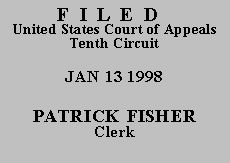

| UNITED STATES OF AMERICA,
Plaintiff-Appellee, v. NELSON BEGAY, Defendant-Appellant. |
|
Defendant appeals from the denial of his motion to vacate, set aside, or correct sentence under 28 U.S.C. § 2255. He contends that one of two counts in his July 1991 indictment for child sexual abuse, relating to conduct occurring between January 1 and March 1, 1986, was barred by the five-year statute of limitations set out in 18 U.S.C. § 3282. The dispositive issue is whether a more recently enacted tolling provision for such offenses, which extends the limitations period until the victim reaches the age of twenty-five, see 18 U.S.C. § 3283 (formerly 18 U.S.C. § 3509(k)), took effect before March 1, 1991, when the five-year period for the challenged count expired. The district court held that the latter provision took effect upon its enactment on November 29, 1990, and, accordingly, denied the motion. We review this legal determination de novo, see generally United States v. Cox, 83 F.3d 336, 338 (10th Cir. 1996), and affirm for substantially the reasons stated by the district court.
The tolling provision in question was passed as § 225(a) of Public Law No. 101-647, 104 Stat. 4789, 4798 (1990). Relying on § 3631 of the same legislation, which states that "this Act . . . shall take effect 180 days after the date of [its] enactment," defendant contends the effective date for § 225(a) was postponed until May 28, 1991. A brief review of the structure of Public Law No. 101-647, and the placement of §§ 225 and 3631 therein, reveals the spuriousness of this contention.
Public Law No. 101-647 has thirty-seven titles known in aggregate as the Crime Control Act of 1990, but reflecting an array of substantively heterogeneous pieces of legislation, many bearing independent "Act" appellations. Thus, as the Historical and Statutory Note to 28 U.S.C. § 3001 indicates, and numerous cases illustrate, the 180-day delay imposed by § 3631 for "this Act" actually relates to Title XXXVI of Public Law No. 101-647, "popularly known as the Federal Debt Collection Procedures Act of 1990." See, e.g., Selbe v. United States, 912 F. Supp. 202, 205 (W.D. Va. 1995); United States v. Dickerson, 790 F. Supp. 1583, 1584 (M.D. Ga. 1992); United States v. Gelb, 783 F. Supp. 748, 751-52 (E.D.N.Y. 1991). Section 225(a), in contrast, is a criminal code provision having nothing to do with the FDCPA, textually or substantively.
Section 225(a) has no dedicated effective date provision and, hence, is governed by the settled rule that "absent a clear direction by Congress to the contrary, a law takes effect on the date of its enactment." Gozlon-Peretz v. United States, 498 U.S. 395, 404 (1991); see Bradshaw v. Story, 86 F.3d 164, 166 (10th Cir. 1996). We therefore conclude that "section 225(a) . . . took effect on the date of enactment of Pub.L. 101-647, which was approved Nov. 29, 1990." Historical and Statutory Note to § 3509. As the statute of limitations had not at that time expired on defendant's child abuse offenses, § 225(a) properly applied and extended the limitations period beyond the date of indictment. See United States v. Johns, 15 F.3d 740, 743 (8th Cir. 1994) (similarly holding § 3509(k) extended time-bar before limitations period for defendant's sex offenses expired on December 1, 1990). See generally United States v. Taliaferro, 979 F.2d 1399, 1402 (10th Cir. 1992) ("application of an extended statute of limitations to offenses occurring prior to the legislative extension, where the prior and shorter statute of limitations has not run as of the date of such extension, does not violate the ex post facto clause"). Defendant's associated claim of ineffective assistance of counsel, based on the failure to assert the time-bar, obviously must fall with the defense on which it is premised.
The judgment of the United States District Court for the District of Utah is AFFIRMED.
Entered for the Court
Circuit Judge
*. This order and judgment is not binding precedent, except under the doctrines of law of the case, res judicata, and collateral estoppel. The court generally disfavors the citation of orders and judgments; nevertheless, an order and judgment may be cited under the terms and conditions of 10th Cir. R. 36.3.